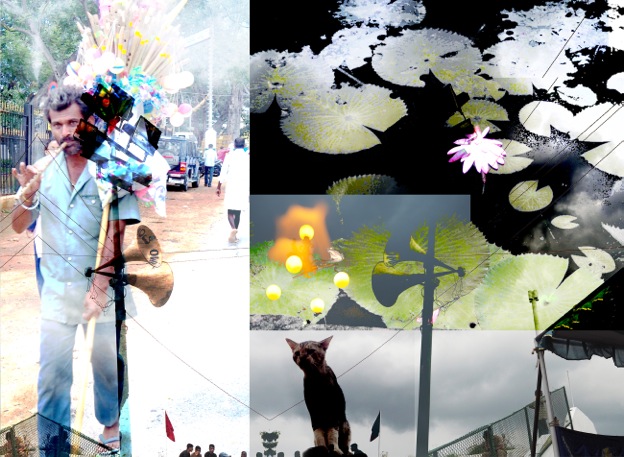

radia season 40 – show #677 (radio x) – RESOUNDING BANGALORE (RE) by GABI SCHAFFNER
– playing from march 19 to march 25, 2018 –

RESOUNDING BANGALORE (RE)
by GABI SCHAFFNER
“Sounds in India are strangely alive! For me, they form autonomous entities: a bell resounding through layers of different memories, the swish of a broom dusting flights of cerebral chambers, a train travelling beyond the boundaries of one’s own biography. ‘Resounding Bangalore’ is a journey in itself and an invitation to cherish an indigenous sound world played back through the ears of a “stranger”…… with no constraints to timelines and topographies.
‘Resounding Bangalore’ was composed on the occasion of an epigynous radio art performance in India, when I was staying there within the frame of the Goethe Institute’s BangaloREsidency in collaboration with the arts and media collective maraa. This radia edit is a slightly extended version of it.”
[Gabi Schaffner)
RE = RADIA EDIT = This piece is a special pre-edit for radia by raw audio.
GABI SCHAFFNER
is an interdisciplinary sound artist, curator, writer and photographer based in Berlin.
Travelling forms a vital part of her work – as a source for sound and language recordings but also as ‘a rite of passage’ enabling the artist to explore alternative narrative structures. Her works in the field of radio art have been broadcast internationally, including commissions for Deutschlandradio, SWR, ABC Australia and many more. In 2012 and 2014, she staged in collaboration with Pit Schultz/reboot.fm a garden radio station in Berlin and in Giessen, Hessia, both featuring international as well as local artists and gardeners. Since 2011 she has been creating several shows for radia.fm.
Find out more about her projects at rawaudio.de and at www.datscharadio.de.
metadata:
RESOUNDING BANGALORE (RE)
by GABI SCHAFFNER
radia production: miss.gunst [GUNST + radiator x]
production date: february 2018
station: radio x, frankfurt am main (germany)
length: 28 min.
licence: (cc-by-nc) GABI SCHAFFNER
www.radiox.de – www.gunst.info – rawaudio.de – www.datscharadio.de
credits:
great many thanks to GABI SCHAFFNER!
additional info:
includes radia jingles (in/out), station and program info/intro (english)
links:
radio x & radiator x: www.radiox.de – www.radiox.de/radiator-x
GUNSTradio & radiator x: www.gunst.info – www.gunst.info/radiator
Gabi Schaffner: rawaudio.de – www.schaffnerin.net
pic:
(c) Gabi Schaffner
Radiophonium
Please for this show, put your headphones !!!
What is binaural sound ? It’s a recording technique that try to reproduce the natural human hearing, created by our head and ears. This three dimensional acoustic experience is not a new idea, it’s been experimented since the 60’s. But it seems there is a new boom for binaural recordings…
With some musicians and dancers, we decided to experiment this binaural stuff, recording sounds simply using 2 little DPA microphones stuck in our ears in order to create new sensations to our listeners. This project is called RADIOPHONIUM. And here are some « work in progress » pieces extract from our experimental sessions.
Bon voyage…
1/ Drei Punkt #1 – (5’20) / by Anne-Laure Lejosne
Flutes: Juliette Faure
Cello : Soizic Lebrat
Danse : Alice Duchêne
Switching between Alice and Juliette’s ears.
2/ Dispositif BACH : Prélude
D’après le prélude de la 1ere suite pour violoncelle seul de Johann Sebastian Bach.
2 speakers and one cellist playing the Prelude with different speed and one dancer carrying the microphones in her ears. Can you hear the movement ?
3/ Cello à roue électrique et à archet & appeaux #1 – (4’46) / by Anne-Laure Lejosne
Roue électrique actionnée sur le violoncelle, doublée par 2 hauts-parleurs disposés de façon à former un triangle. Les microphones miniatures sont dans les oreilles de la preneuse de son, en mouvement : élévations rapides devant les HP, tourbillons…
4/ La petite hirondelle
Cello : Soizic Lebrat
Voice : Alice Duchêne
Microphones in Soizic’s ears
5/ Dispositif BACH : Sarabande
Danse and ears : Alice Duchêne
6/ Sol #2 – (4’) / by Anne-Laure Lejosne
Dispositif de captation binaurale sur les oreilles de la violoncelliste et sur la danseuse Juliette. Quelques superpositions des 2 captations.
Cello : Soizic Lebrat
Voice : Alice Duchêne
Flute : Anne-Laure Lejosne
7/ Dispositif BACH : Gigue
Danse and ears : Alice Duchêne
8/ Sol#1#2#3 – (3’35) / by Soizic Lebrat
———
Le binaural est une technique d’enregistrement cherchant à reproduire la perception sonore naturelle humaine. En quelques mots, l’écoute binaurale consiste à reproduire un espace tridimensionnel en reproduisant les indices qu’utilise notre cerveau pour situer les sons dans l’espace (latéralité, profondeur, élévation). Ces indices de localisation spatiale découlent, comme pour les couples microphoniques stéréo, de différences de temps et d’intensité, mais également des transformations spectrales qu’opère la morphologie de l’auditeur.
La captation binaurale propose donc de reproduire le champ sonore induit au niveau des oreilles de l’auditeur/preneur de son, en prenant en compte sa morphologie. Concrètement il s’agit de placer deux microphones miniatures dans le creux de l’oreille du preneur de son. Pour bénéficier de la sensation d’immersion que procure le binaural, le port d’un casque est obligatoire !
« Radiophonium » est un projet en cours de construction, élaboré par la violoncelliste Soizic Lebrat et Anne-Laure Lejosne à la prise de son. Ce projet musical protéiforme place, au cœur de l’écriture, l’écoute des performeurs grâce à cette fameuse technique de l’enregistrement binaural, à savoir 2 micro miniatures glissés dans nos oreilles. L’auditeur se retrouve alors dans les oreilles des performeurs. Il entre dans l’intimité du musicien(ne) ou du danseur(se). Une façon de mettre l’oreille à nu et de donner accès à ce qui met en mouvement le performeur, avec l’espoir de percer un peu de ce mystère de l’écoute…
http://soiziclebrat.eu/radiophonium/